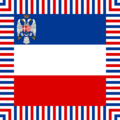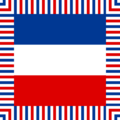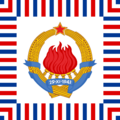Ministry of Defence (Yugoslavia) facts for kids
| Serbo-Croatian: Ministarstvo odbrane/Министарство одбране Slovene: Ministrstvo za obrambo Macedonian: Министерство за одбрана |
|
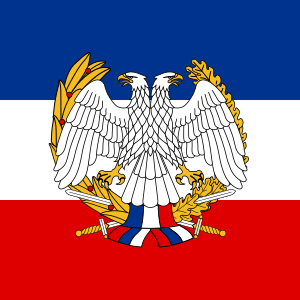
Standard of the Minister of Defence (1995–2006)
|
|
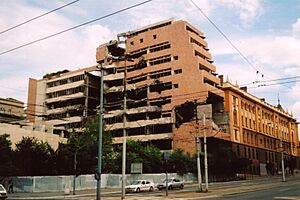 The Yugoslav Ministry of Defence building (damaged in the NATO bombing of Yugoslavia) |
|
| Ministry overview | |
|---|---|
| Formed | 1 December 1918 |
| Dissolved | 4 June 2006 |
| Jurisdiction | Yugoslavia, Serbia and Montenegro |
| Headquarters | Yugoslav Ministry of Defence building, Belgrade (1965–99) 44°48′20″N 20°27′40″E / 44.80556°N 20.46111°E |
| Ministers responsible |
|
| Parent department | Federal Executive Council (1953–92) |
The Ministry of Defence was a government department in Yugoslavia and later in Serbia and Montenegro. Its main job was to manage the country's armed forces and protect the nation. This ministry existed under different names throughout history.
For example, from 1918 to 1941, it was called the Ministry of the Army and Navy in the Kingdom of Yugoslavia. Later, from 1945 to 1992, it was known as the Federal Secretariat of People's Defence in the Socialist Federal Republic of Yugoslavia. Finally, from 1992 to 2006, it was simply the Ministry of Defence for Serbia and Montenegro. The building where the Yugoslav Ministry of Defence was located in Belgrade was damaged during the NATO bombing of Yugoslavia.
Leaders of Defence in Yugoslavia
The person in charge of defence changed names over time, just like the country itself. These leaders were very important for keeping the country safe.
Defence Leaders in the Kingdom of Yugoslavia (1918–1941)
During the time of the Kingdom of Yugoslavia, the main defence leader was called the Minister of the Army and Navy. This person was responsible for both the land forces and the naval forces.
- Mihailo Rašić was the first Minister of the Army in 1918. He then became the first Minister of the Army and Navy.
- Stevan Hadžić served multiple times as Minister of the Army and Navy.
- Branko Jovanović was a minister who sadly died while in office.
- Petar Pešić also served as Minister of the Army and Navy more than once.
- Milan Nedić was another important Army general who held this position.
- Bogoljub Ilić was the last Minister of the Army and Navy before the Kingdom of Yugoslavia ended in 1941.
Defence Leaders During World War II (1941–1945)
During World War II, Yugoslavia had a government-in-exile, meaning it operated from outside the country. They also had defence leaders.
- Bogoljub Ilić continued as Minister of the Army and Navy for a short time.
- Dragoljub Mihailović, a Brigadier general, became Minister of the Army and later Minister of the Army, Navy and Air Force.
- Dušan Simović was Minister of the Air Force and Navy.
- Ivan Šubašić served as an acting minister during this period.
At the same time, a group called the National Committee for the Liberation of Yugoslavia was fighting against the occupation. Their leader was also in charge of defence.
- Josip Broz Tito was the Commissioner for Defence for the National Committee. He was a very important military leader.
Defence Leaders in Socialist Yugoslavia (1945–1992)
After World War II, Yugoslavia became a socialist country. The defence leader was known as the Federal Secretary of People's Defence. This person was the most powerful military figure in the country.
- Josip Broz Tito was the first Federal Secretary of People's Defence. He was also the country's president.
- Ivan Gošnjak served for a long time as the Federal Secretary.
- Nikola Ljubičić was another long-serving Federal Secretary.
- Branko Mamula was an Admiral who held this important role.
- Veljko Kadijević was the last Federal Secretary before Yugoslavia began to break apart.
- Blagoje Adžić and Života Panić served as acting Federal Secretaries during a time of big changes.
Timeline of Federal Secretaries

Defence Leaders in FR Yugoslavia / Serbia and Montenegro (1992–2006)
After many parts of Yugoslavia became independent countries, Serbia and Montenegro formed a new country called the Federal Republic of Yugoslavia (FR Yugoslavia) in 1992. In 2003, it changed its name to Serbia and Montenegro. The defence leader was again called the Minister of Defence.
- Milan Panić was the first Minister of Defence for FR Yugoslavia.
- Pavle Bulatović served as minister for a long time, but he sadly died in office.
- Dragoljub Ojdanić was a General of the Army who took over the role.
- Slobodan Krapović and Velimir Radojević also served as ministers.
- Boris Tadić later became the Minister of Defence.
- Prvoslav Davinić was another minister during this period.
- Zoran Stanković was the last Minister of Defence before Serbia and Montenegro became two separate independent countries in 2006.
Standards and Symbols
The Ministry of Defence had special flags, called "standards," to represent its authority and history. These flags changed over time as the country and its defence ministry evolved. They are important symbols of the military's role in protecting the nation.
Related Defence Ministries
Many countries that were once part of Yugoslavia now have their own defence ministries. You can learn more about them here:
- Ministry of Defence (Bosnia and Herzegovina)
- Ministry of Defence (Croatia)
- Ministry of Defence (Montenegro)
- Ministry of Defense of North Macedonia
- Ministry of Defence (Serbia)
- Ministry of Defence (Slovenia)


